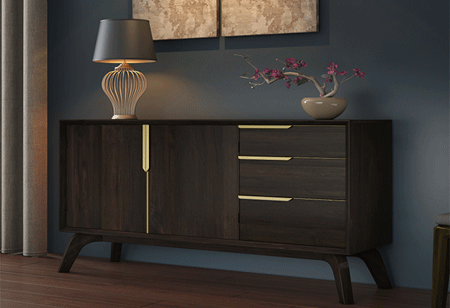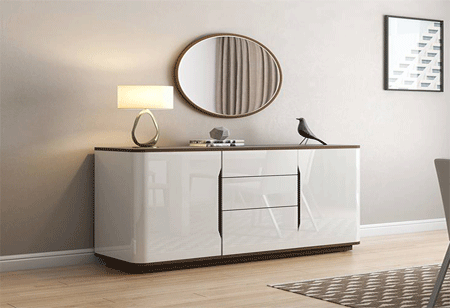
In an exclusive interview with charulatha, Correspondent, Homes India Magazine, Maya Mathew delves deep into the trends, opportunities and challenges in the credenza market.
Maya Mathew, cultivated her love for Art and Design right from an early age. She excelled at Srishti School of Art, Design, and Technology, specializing in product and interface design. With nearly 15 years of experience, Maya focuses on crafting lifestyle products and furniture, believing each piece holds the potential for cherished memories, reflecting an individual's unique essence. She sees the home as a powerful form of self-expression, valuing both heirlooms and collective family choices. For over a decade, she has shaped Urban Ladder’s design language, maintaining a distinctive identity while simultaneously appealing to a broader audience.
As Head of Design at urban adder, Maya leads a dynamic team in digital visual merchandising, furniture design, upholstery, and textiles, ensuring a commitment to innovative design excellence in every project.
How has the credenza or sideboard evolved throughout history and how does it fit into modern living spaces today?
The credenza or sideboard, often overlooked from a furniture perspective, holds a rich history of evolution. Originating in 14th-century Italy, it was initially a dining-centric fixture, employed for food placement and tasting to ensure safety. Over centuries, its purpose has transformed gradually. Today, it serves as a versatile storage unit, offering functionality through drawers, shelves, and shutters. Some variants even incorporate display elements. In today's open-plan homes, the credenza is versatile, finding purpose in living, bedroom, or dining spaces. Beyond functionality, it can make a design statement. Material, finish, legs, hardware, and accents enhance its look. However, one should diligently consider the interior style ensures seamless integration.
 What considerations should one keep in mind when selecting the appropriate size and shape of a credenza to harmonize with the layout and dimensions of their room?
What considerations should one keep in mind when selecting the appropriate size and shape of a credenza to harmonize with the layout and dimensions of their room?
When selecting sideboards or credenzas, space considerations are paramount. Tailor the piece to your available space and opt for compact options like two-door sideboards for smaller homes. There are various configurations, from low to high units, even those with glass displays on top, optimizing vertical space. Urban Interiors offer custom-made, modular sideboards, seamlessly integrated into your space with customizable sizes, materials, and storage options.
"Urban Interiors offer custom-made, modular sideboards, seamlessly integrated into your space with customizable sizes, materials, and storage options."
What materials are commonly used to make credenzas or sideboards, and how does the choice of material affect their overall aesthetic and durability?
Sideboards and credenzas' material choice depends on your existing interior style. They're typically made from solid woods like beech, Sheesham, mango, teak, or engineered options like MDF or particle board. Leg options vary from metal, wood, or no legs, allowing floor placement. Different materials cater to various aesthetics, offering diverse finishes, handles, inlays, carvings, and accents such as cane or glass. Transitional design, blending traditional and contemporary elements, is popular in Indian homes. Traditional styles draw from colonial eras, while modern options range from Scandinavian to minimalist. Bohemian chic adds vibrancy, and industrial styles mix wood, metal, and glass for a utilitarian effect. One should choose based on whether you want the piece to blend or stand out in your overall interior design.
 How can accessories, such as lighting, artwork, or decorative items, be strategically incorporated to enhance the overall look and functionality of a credenza or sideboard?
How can accessories, such as lighting, artwork, or decorative items, be strategically incorporated to enhance the overall look and functionality of a credenza or sideboard?
Decorating a credenza serves both functional and aesthetic purposes. It provides an accessible platform for cherished items, from photo frames to artworks. Adding a mirror or art piece above enhances the visual appeal. A well-chosen lamp or sculptural element adds sophistication, while a tastefully arranged vase brings natural elegance. These accessories harmonize, accentuating the credenza's character. If suitable, carefully curated books can add an intellectual dimension. In the case of a glass-accented sideboard, it offers ample space for displaying treasured crockery and mementos. This allows individuals to proudly showcase tokens from their travels, adding a personalized touch to the space.
Discuss the role of colors and finishes in credenza or sideboard design, and how these elements can tie into a room's color scheme.
Choosing a colored sideboard often signals a desire for a statement piece. Options range from elegant white for a clean aesthetic to matte black for a more edgy appeal. There are also choices like teak, mahogany, walnut, and lighter wood tones. The finish should harmonize with existing furniture and the room's ambiance. Darker wood finishes suit classic, transitional designs, while lighter ones evoke Bohemian, Scandinavian, or Japanese influences. Additionally, mixed materials add another layer of design complexity. One should consider hardware like handles or knobs, which can enhance the desired aesthetic. For a chic look, options like brass or rose gold handles can be integrated. Ultimately, the decision depends on whether the piece should be a focal point or seamlessly integrate into the room's overall design, tailored to the customer's preferences.
"Decorating a credenza serves both functional and aesthetic purposes. It provides an accessible platform for cherished items, from photo frames to artworks"
How do you stay updated on current design trends and evolving customer preferences?
For instance, Urban Ladder's Taarkashi ideboard, introduced five years ago, embraced the growing brass trend by subtly integrating brass inlay. Available in two versions - one with a built-in bar and another with ample storage - it met evolving market demands, offering both functionality and style. Lastly, align choices with your aesthetic, selecting pieces that reflect your individuality. This is crucial for creating a uniquely personalized space, where your personal expression truly shines.
We use cookies to ensure you get the best experience on our website. Read more...
Copyright © 2025 HomesIndiaMagazine. All Rights Reserved.